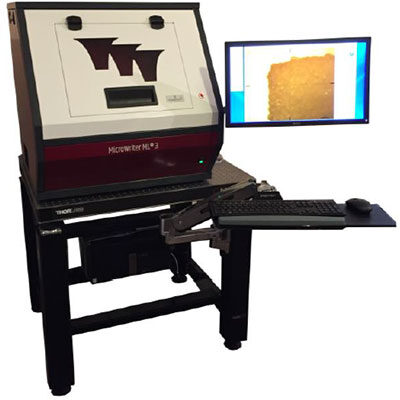In a first-of-its-kind for Africa, the Department of Electrical and Electronic Engineering in the Faculty of Engineering at Stellenbosch University recently acquired the Durham Magneto Optics MicroWriter ML®3, a world-class machine used for micro-manufacturing capabilities.
This machine offers diverse opportunities for research, including cutting-edge medical projects like organ-on-chip medical research, with applications in drug discovery, cancer diagnosis and treatment, cell culture models (growing and maintaining cells in a laboratory) and more.
About the Durham Magneto Optics MicroWriter ML®3
Known as the Durham Magneto Optics MicroWriter ML®3, this machine will be used for various microfluidic projects at the University. Microfluidics involves the design and study of devices that manipulate or analyse tiny amounts of liquid. Additionally, it will serve as a national fabrication facility for researchers nationwide.
Some of the projects that will benefit from this machine include cutting-edge organ-on-chip medical research, with applications in:
- drug discovery;
- cancer diagnosis and treatment;
- modelling diseases; and
- ultra-sensitive optical biosensors and cell culture models.
These projects involve growing and maintaining cells in a laboratory and cell filtration and manipulation.

Fig 1: The MicroWriter ML®3
How Does It Work?
Daniël Retief, a PhD candidate and nano-lab manager at the Department of Electrical and Electronic Engineering, explains that a micro writer uses very precisely focused light to create patterns in light-sensitive materials. These patterns can then be selectively removed, leaving behind only the desired patterns.
This capability facilitates the production of micrometer-scale structures, including microscopic channels designed for manipulating individual blood or bacterial cells, catering to diverse applications. The machine’s reliable creation extends down to structures as narrow as 0.5 micrometers wide, roughly 200 times smaller than the diameter of a human hair.
Benefits of the MicroWriter ML®3
According to Daniël, one of the main advantages of this machine is its ability to produce virtually any pattern or design at a very high speed without the need for a photo mask or the complex supporting infrastructure typically required by mask-aligners, which are an alternative to micro-writers.
This machine allows for rapid prototyping and iteration without the need to create masks. Making a mask is very expensive, as a new mask must be produced for each pattern and cannot be altered once made. In contrast, the MicroWriter has an onboard device that acts as a mask, enabling exposure of any pattern at any time. Daniël explains:
“Our goal is to develop local manufacturing capacity and skills, reducing South Africa’s reliance on others for high-tech manufacturing. With the acquisition of this machine, we now possess world-class micro-manufacturing capabilities, enabling us to compete in fields such as MEMS (microelectromechanical systems), laser optics, very high-frequency electronics, biosensors, and more”
Going Forward
The Department is excited to explore the MicroWriter’s capabilities so it can fully exploit its potential. The MicroWriter is one of several machines required to establish a world-class biosensors and microfabrication facility at Stellenbosch University.
It will be installed in a cleanroom once the refurbishment of the Electrical and Electronic Department is completed this year. In the meantime, some of the equipment is housed in a temporary laboratory in SU’s Department of Chemistry, while the rest is in storage.
The MicroWriter ML3 is part of the Nano-Micro Manufacturing Facility (NMMF) established by the Department of Science and Innovation in 2022. The NMMF’s mission is to encourage research in nano- and microscale manufacturing and support industry partners in exploring and advancing state-of-the-art technologies. The facility consists of five nodes located throughout the country, with each node specialising in specific fields. Stellenbosch University’s node, which concentrates on biosensors, stands to gain significant advantages from acquiring the MicroWriter ML3.
You can read the online press at https://www.engineeringnews.co.za/article/su-opens-new-avenues-for-localisation-with-high-tech-micro-manufacturing-machine-2024-02-20 and https://www.eng.sun.ac.za/first-microwriter-ml3-in-africa/





